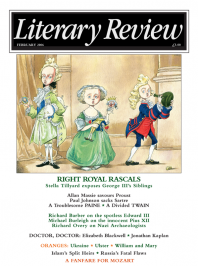Lucy Beresford
Love Among The Rubble
The Night Watch
By Sarah Waters
Virago 440pp £16.99
War is a popular backdrop for novels, particularly love stories. The heightened emotions fuelled by apocalyptic conditions provide rich targets for a novelist’s searchlight. Waters has turned hers full beam onto London during and just after the Second World War, and in particular onto issues of cowardice and bravery. Par for the course, you might think, in war. But with Waters we have learned (from her earlier novels Fingersmith and Tipping The Velvet) to expect the unexpected.
The ‘twist’ (if one can call it that) in The Night Watch is Waters’s accomplished structure. Divided into three sections, it tells backwards the narratives of four loosely linked characters, and it is this inversion which invests the novel with its potency. Without betraying elements of the plot, I can

Sign Up to our newsletter
Receive free articles, highlights from the archive, news, details of prizes, and much more.@Lit_Review
Follow Literary Review on Twitter
Twitter Feed
Under its longest-serving editor, Graydon Carter, Vanity Fair was that rare thing – a New York society magazine that published serious journalism.
@PeterPeteryork looks at what Carter got right.
Peter York - Deluxe Editions
Peter York: Deluxe Editions - When the Going Was Good: An Editor’s Adventures During the Last Golden Age of Magazines by Graydon Carter
literaryreview.co.uk
Henry James returned to America in 1904 with three objectives: to see his brother William, to deliver a series of lectures on Balzac, and to gather material for a pair of books about modern America.
Peter Rose follows James out west.
Peter Rose - The Restless Analyst
Peter Rose: The Restless Analyst - Henry James Comes Home: Rediscovering America in the Gilded Age by Peter Brooks...
literaryreview.co.uk
Vladimir Putin served his apprenticeship in the KGB toward the end of the Cold War, a period during which Western societies were infiltrated by so-called 'illegals'.
Piers Brendon examines how the culture of Soviet spycraft shaped his thinking.
Piers Brendon - Tinker, Tailor, Sleeper, Troll
Piers Brendon: Tinker, Tailor, Sleeper, Troll - The Illegals: Russia’s Most Audacious Spies and the Plot to Infiltrate the West by Shaun Walker
literaryreview.co.uk